


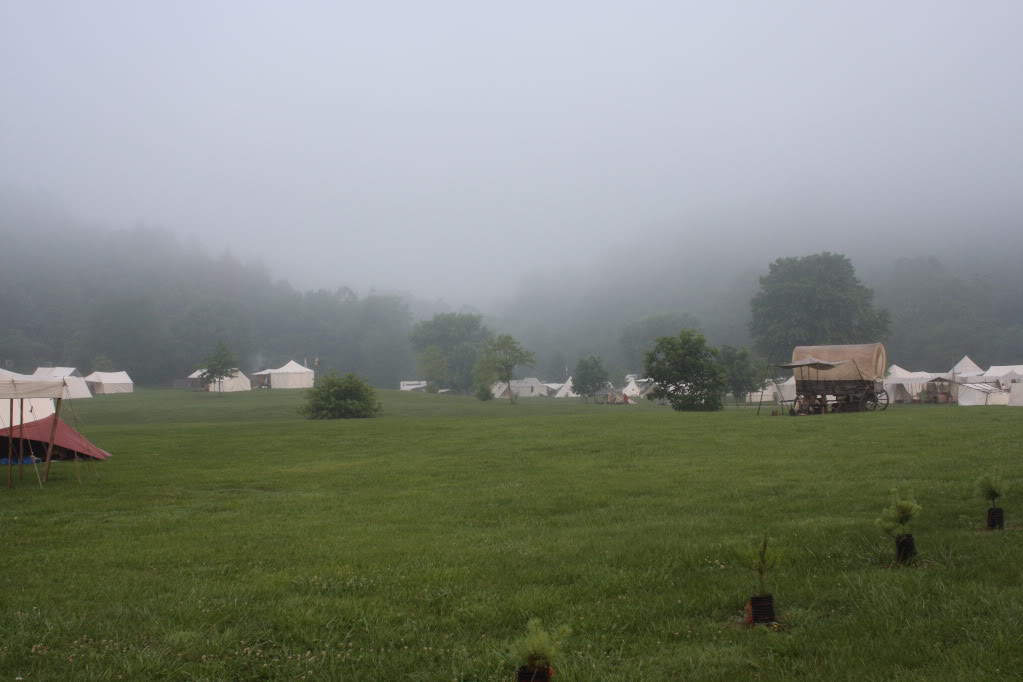
Ever see a shooting line a quarter mile long? Ever seen a muzzleloading slug gun that weighed over 100 lbs? Ever watched a barrel being rifled by hand? Ever seen a shooter bust doubles with a double flint fowler? You can for 10 days each spring and fall in southern Indiana. Come join us! Editor: Larry Pletcher
The Spring Shoot at Friendship is over, and as usual the trip was a treat. It’s hard to explain the many experiences. Whether it’s talking with old friends, looking for parts for another project, or drooling over the wonderful guns on display, the trip is a memorable one. But wait we forgot to mention the shooting competition. There is a match for about every gun and sight combination possible.
The purpose of this article is to give you a taste of Spring NMLRA shoot. The photos are on multiple pages to make them faster to load. One can’t cover everything, but you’ll get the idea.
Links below will take you to photo groupings based on general topics.
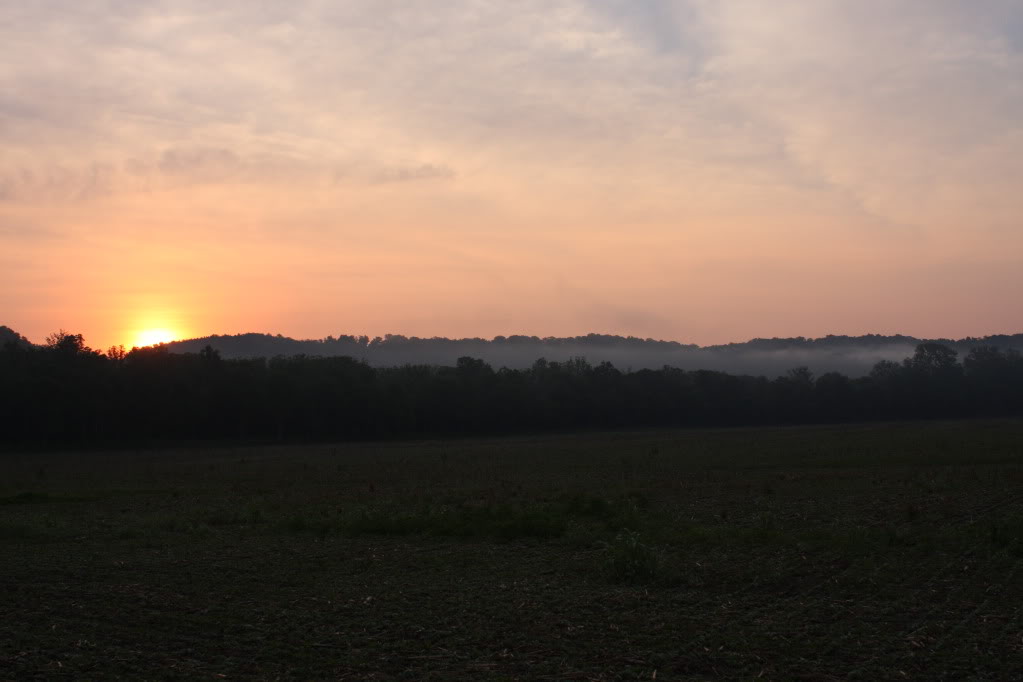
Gallery One contains photos of the grounds, although many of these will overlap topics.
Editor: Larry Pletcher
The physical grounds change from time to time. The entrance to Primitive is recent, but the Education Building had its Grand Opening this spring. This project was completed completely with donations. The building has a kitchen, a large room for meetings or banquets, and a number of small meeting rooms.
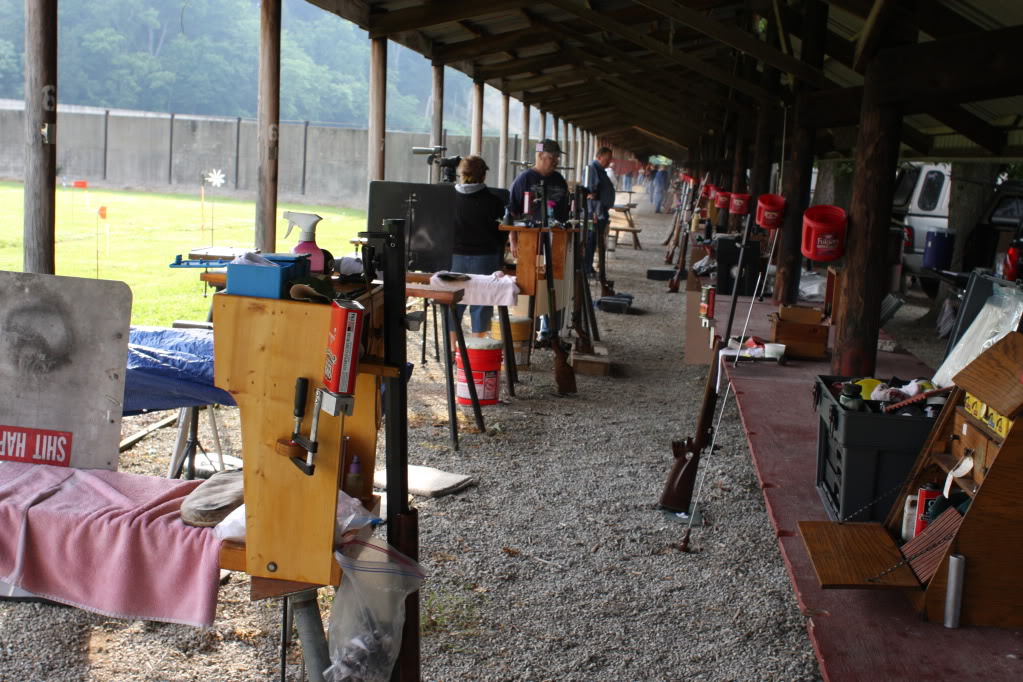
Shooting Positions
Let’s take a look at shooting competition at Friendship. Included in the main shooting line are Pistol, Offhand, Cross Sticks, Bench rest, Silhouettes, LongRange, Slug Guns, and Chunk Guns. Next to the Pistol Line is the Trap Range. A short walk up the dry creek bed is Skeet and the Quail Walk. Muzzleloaders of every description are shot here based on the type and the sights used.
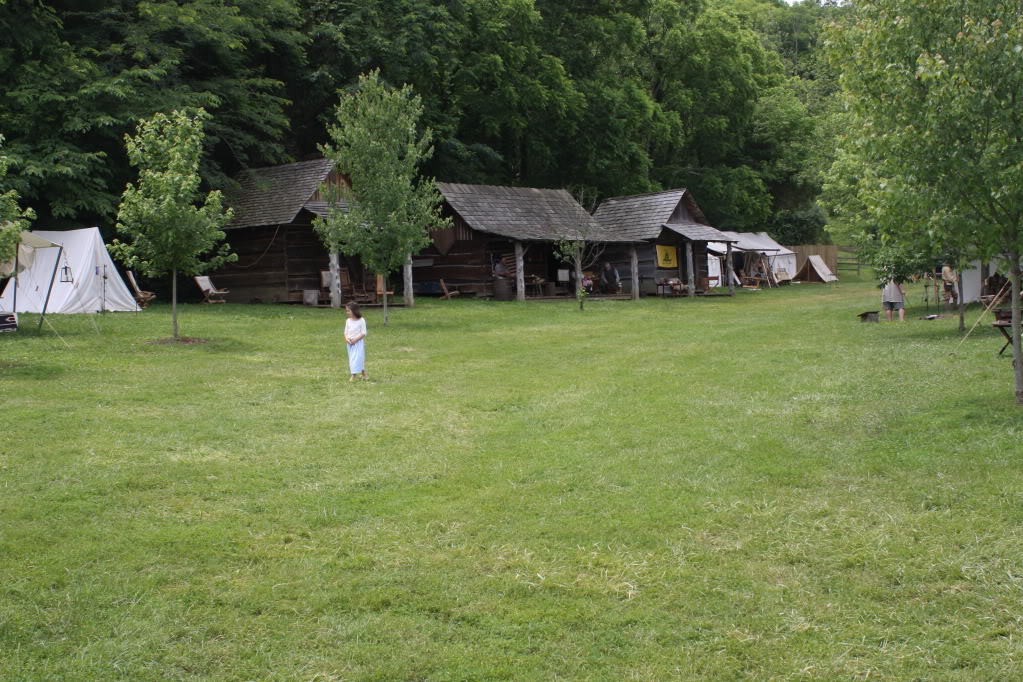
Primitive Range
The Primitive Range is our next stop. While there are many matches for primitive guns on the regular range, the primitive range is for primitive muzzleloaders exclusively. Here you will see shooters in costume firing flintlock rifles and fowling pieces – just to name a few. You might even see a rare breech-loading Ferguson rifle here. Again there are many matches. The Mountain Man Aggregate includes flint/steel fire starting , tomahawk and knife throwing as well.
A five photo sequence of a Ferguson Rifle firing.
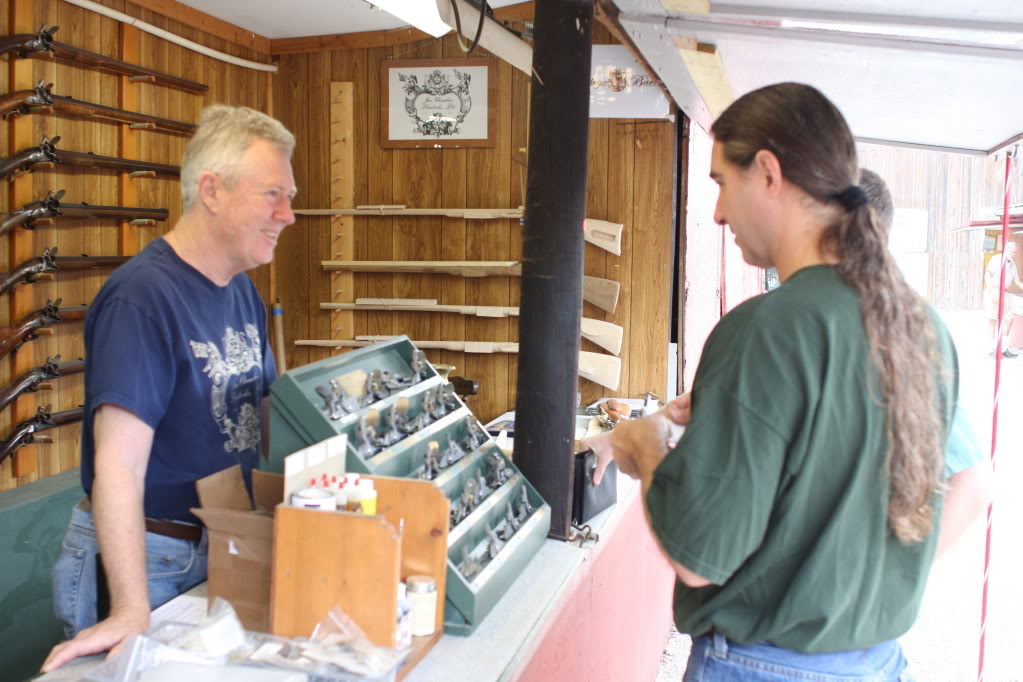
Commercial Row, Gun Makers Hall
Next we’ll check out Commercial Row and Gun Makers Hall. If you need a hawk or knife, parts for a new gun, or about any other muzzleloading accessory, you can probably find it shopping these booths. If you need a barrel, Rice barrels are here. Chambers, Davis, and L&R locks are here. Wayne Dunlop has amazing wood.
Gun Makers Hall is an amazing place. Some of the most beautiful guns hang on display here. Behind the hall you can watch barrels being rifled and fellows working on guns, answering questions as they work. You might see a fellow timing flintlocks with a computer, or a high speed video project going on, capturing flintlocks in slow motion.
I always have friends I need to see. One stop is always at Jim Chambers booth. For 20 years he has listened to my ideas for experiments and offered great advice. Mike Miller is one of my regular stops. He is finishing a gun for me this summer. Mark Silver, Tom Snyder, Gary Brumfield, Wallace Gusler, and David Price. can be seen here.
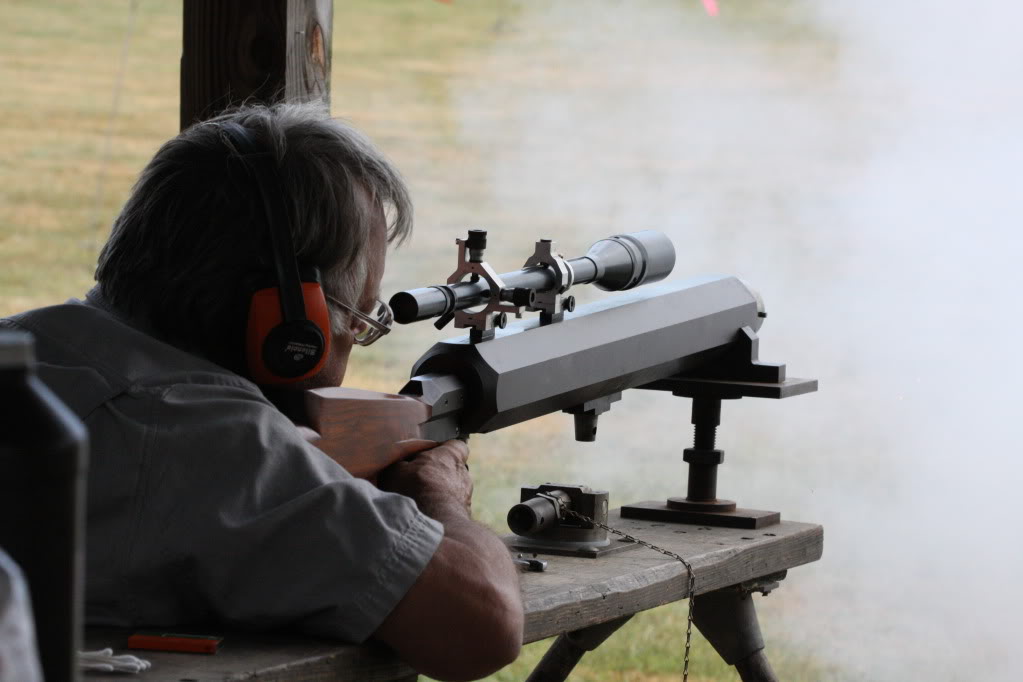
Blackpowdermag editor, Larry Pletcher
For years I’ve been fascinated with the slug guns during the Muzzleloading Championships at Friendship. This year I decided to do an article on these remarkable guns. This article is the first in a two part series on slug guns. The second will look at the largest slug gun I have ever seen.
Slug gun shooting has a long tradition in the NMLRA. During my 30+ years of trips to Friendship, visits to the slug gun range have been a part of my plans. This year I decided to write up my experiences
The slug gun is unique among the various types of blackpowder guns. The typical muzzleloading slug gun is heavy often 30-40 pounds. The largest known slug guns exceed 100 pounds. One of these amazing guns was shot this year. The barrels are large diameter, shorter than round ball bench gun barrels, but do use a false muzzle. The actions are the underhammer variety with sealed ignitions. (Sealed ignitions completely enclose the cap, preventing gases from escaping the barrel at the nipple.)
Typical barrels are rifled for a .45 bullet with a 1 turn in 18” twist. Other calibers are seen at Friendship from .40s to the huge .69 caliber that appeared this year. Mounted on the barrel is a target quality telescopic sight. These vary in power; 24x seems to be the optimum for this type of shooting. (Higher powers tend to have greater problems with mirage.) Scope adjustments are in the mounts.
The typical .45 caliber bullet weighs 550 grains while the .69 caliber bullet weighed more than three times as much. The bullet is normally swaged from two pieces – a harder nose swaged to a softer base. This prevents the nose from deforming but allows the base to bump up into the rifling. Many shooters design their own bullets, casting their own cores, and swaging the complete bullet. A typical bullet design would use three calibers as the length.
The bullet is wrapped in a paper patch. Most shooters use the cross patch method. Narrow strips of paper are positioned on the false muzzle, the bullet placed on top, and the bullet carefully seated with a mechanical seating tool. The seating device may be a plunger whose nose is machined to fit the nose of the bullet. Another device uses levers to provide mechanical advantage.
Every trick is used to produce the smallest groups. Even though bullets are swaged, they are culled very close tolerances. Powder is pre-weighed. I saw one shooter with an enclosed weighing and charging station, designed to prevent a breeze from changing the delicate scale’s reading.
Shooting a slug gun involves many skills, among those is the ability to handle the wind. The ability to read wind flags is not unique to slug gun shooting, but shooting paper targets at 500 yards requires a shooter to develop these skills. That being said, George Mitchell, who shoots the 100 pound, .69 caliber gun, said he didn’t worry about wind too much. He probably does, but his huge, 1785 grain, bullet does have wind-bucking abilities.
I found the slug gun shooters a helpful group when I gathered information for this article. I was careful to wait for relays to end before asking questions. I was allowed access to take pictures and to develop the loading sequences shone in the photos. All were free with details about their guns, scopes, loading equipment, and bullets.
The guns, equipment, and the shooters make slug gun shooting a truly unique experience at Friendship. Take the time to visit the slug gun range. Part 2 of this Slug Gun series will zero in on the largest gun at Friendship this fall. The photo below, I hope will whet your appetite.
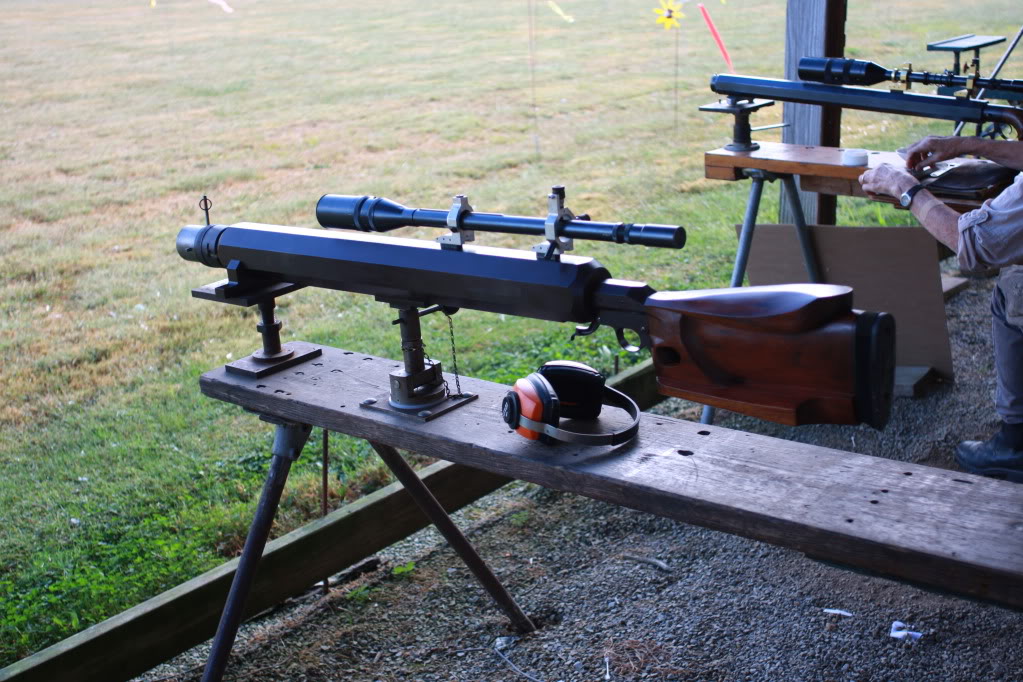
Slug Guns Part 2 allows a unique look into the world of slug guns. Blackpowdermag.com is pleased to bring you this look at the “Mother of all Slug Guns.”
Blackpowdermag editor, Larry Pletcher
In Part 1 the topic was slug guns in general; Part 2 zeroes in on one of the largest slug guns ever to be fired at Friendship. This gun, built by George Mitchell, is one of four guns in existence made in .69 caliber. All four of these guns are very heavy. The Mitchell gun is over 100 pounds, and it may be the heaviest of the four. It is the only one of the four currently in use.
The gun uses a Morse underhammer action and a sealed ignition. The barrel has a 1 turn in 28 inch twist and uses .004″ deep rifling. The telescopic sight is also built by Mr. Mitchell (Mitchell optics). In fact Mitchell scopes were seen on many of the slug guns shooters on the line.
In most cases these scopes are 24X because larger powers tend to increase the effect of mirage. The adjustment of these scopes is in the mounts like the Unertl target scopes.
Caption: The bullet on the left is 550 gr. .45 caliber ; on the right is the 1785 gr bullet for the Mitchell gun.
The Mitchell gun uses the same basic accoutrements used by most slug guns. Mr. Mitchell uses a chase patch for his 1785 grain two piece bullet. The precut paper is wrapped around form and inserted in a specially made die. The bullet is inserted into the die and the die fit into the false muzzle. A plunger type seating device is used to give the bullet a perfect start into the bore. A bench rod seats the bullet on 300 grains of fg Goex powder.
Caption: The paper patch is wrapped around a form.
Caption: The patch is inserted into a die up to a shoulder using the tool at right.
Caption: Here the bullet has been inserted up to the same shoulder.
Caption: The patch is folded over the bullet’s base. It is now ready for the false muzzle.
Caption: This plunger type seating tool is used to seat the bullet.
One subject that needs to be mentioned deals with the handling of the extra weight when going through loading, cleaning, and benching the gun prior to shooting. Mr Mitchell uses a swivel mounted on the top of his shooting bench. With the gun on the swivel the gun rests on the muzzle and on the swivel; the stock is a few inches off the bench. To ready the gun for firing, a pin is removed from the swivel and the gun is lowered so that the stock rests on the bench.
After firing, the stock of the gun is raised and the gun placed on the swivel. The gun is then rotated on the swivel until the stock can be lowered to the ground. After cleaning and loading, the gun is swung back unto the bench where the swivel can be disconnected and the stock again lowered unto the bench. It seemed that this process was well thought out, and the only time the full weight of the gun was lifted was when it was taken to the bench at the beginning of the shooting session. Moving to and from the range was done with a two-wheeled cart adapted for that purpose.
Caption: Please note the swivel in the center of the bench. This holds the weight until the pin is pulled and the stock lowered to the bench. The gun can be rotated and the stock lowered to the ground. (You may have noticed the false muzzle remaining on the gun while on the bench. Mr. Mitchell had just placed the gun on the bench for taking photos. The false muzzle is left in place when the gun travels and moved to the bench to protect the muzzle.)
Caption: George is making adjustments to his scope.
Caption: You saw this photo at the beginning, but it’s worthy of a second look!
I’d like to thank George Mitchell, his wife, and all those slug gun shooters on the line for their cooperation. Their willingness to help with information and helping to set up photography shots was invaluable.